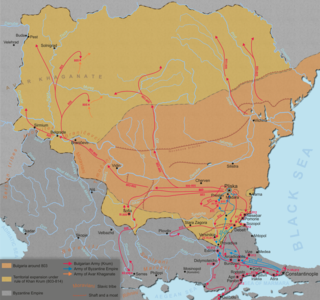The 800s decade ran from January 1, 800, to December 31, 809.
The 810s decade ran from January 1, 810, to December 31, 819.
The 780s decade ran from January 1, 780, to December 31, 789.

Year 804 (DCCCIV) was a leap year starting on Monday of the Julian calendar.

Year 806 (DCCCVI) was a common year starting on Thursday of the Julian calendar, the 806th year of the Common Era (CE) and Anno Domini (AD) designations, the 806th year of the 1st millennium, the 6th year of the 9th century, and the 7th year of the 800s decade.

Year 803 (DCCCIII) was a common year starting on Sunday of the Julian calendar.

Year 802 (DCCCII) was a common year starting on Saturday of the Julian calendar, the 802nd year of the Common Era (CE) and Anno Domini (AD) designations, the 802nd year of the 1st millennium, the 2nd year of the 9th century, and the 3rd year of the 800s decade.
Year 828 (DCCCXXVIII) was a leap year starting on Wednesday of the Julian calendar.

Abū Jaʿfar Hārūn ibn Muḥammad ar-Rāshīd, or simply Hārūn ibn al-Mahdī, famously known as Hārūn ar-Rāshīd, was the fifth Abbasid caliph of the Abbasid Caliphate, reigning from September 786 until his death in March 809. His reign is traditionally regarded to be the beginning of the Islamic Golden Age. His epithet al-Rashid translates to "the Orthodox", "the Just", "the Upright", or "the Rightly-Guided".

Staurakios or Stauracius was the shortest-reigning Byzantine emperor, ruling for 68 days between 26 July and 2 October 811.

Abū ʿAbd Allāh Muḥammad ibn ʿAbd Allāh al-Mahdī, better known by his regnal name al-Mahdī, was the third Abbasid Caliph who reigned from 775 to his death in 785. He succeeded his father, al-Mansur.

In 717–718 Constantinople, the capital of the Byzantine Empire, was besieged for the second time by the Muslim Arabs of the Umayyad Caliphate. The campaign marked the culmination of twenty years of attacks and progressive Arab occupation of the Byzantine borderlands, while Byzantine strength was sapped by prolonged internal turmoil. In 716, after years of preparations, the Arabs, led by Maslama ibn Abd al-Malik, invaded Byzantine Asia Minor. The Arabs initially hoped to exploit Byzantine civil strife and made common cause with the general Leo III the Isaurian, who had risen up against Emperor Theodosius III. Leo, however, deceived them and secured the Byzantine throne for himself.

The Battle of Krasos took place during the Arab–Byzantine Wars in August 804, between the Byzantines under Emperor Nikephoros I and an Abbasid army under Ibrahim ibn Jibril. Nikephoros' accession in 802 resulted in a resumption of warfare between Byzantium and the Abbasid Caliphate. In late summer 804, the Abbasids had invaded Byzantine Asia Minor for one of their customary raids, and Nikephoros set out to meet them. He was surprised, however, at Krasos and heavily defeated, barely escaping with his own life. A truce and prisoner exchange were afterwards arranged. Despite his defeat, and a massive Abbasid invasion the next year, Nikephoros persevered until troubles in the eastern provinces of the Caliphate forced the Abbasids to conclude a peace.
Bardanes, nicknamed Tourkos, "the Turk", was a Byzantine general who launched an unsuccessful rebellion against Emperor Nikephoros I in 803. Although a major supporter of Byzantine empress Irene of Athens, soon after her overthrow he was appointed by Nikephoros as commander-in-chief of the Anatolian armies. From this position, he launched a revolt in July 803, probably in opposition to Nikephoros's economic and religious policies. His troops marched towards Constantinople, but failed to win popular support. At this point, some of his major supporters deserted him and, reluctant to engage the loyalist forces in battle, Bardanes gave up and chose to surrender himself. He retired as a monk to a monastery he had founded. There he was blinded, possibly on Nikephoros's orders.

The Abbasid invasion of Asia Minor in 782 was one of the largest operations launched by the Abbasid Caliphate against the Byzantine Empire. The invasion was launched as a display of Abbasid military might in the aftermath of a series of Byzantine successes. Commanded by the Abbasid heir-apparent, the future Harun al-Rashid, the Abbasid army reached as far as Chrysopolis, across the Bosporus from the Byzantine capital, Constantinople, while secondary forces raided western Asia Minor and defeated the Byzantine forces there. As Harun did not intend to assault Constantinople and lacked ships to do so, he turned back.

The 806 invasion of Asia Minor was the largest of a long series of military operations launched by the Abbasid Caliphate against the Byzantine Empire. The expedition took place in southeastern and central Asia Minor, where the two states shared a long land border.
Khuzayma ibn Khazim ibn Khuzayma al-Tamimi was a powerful grandee in the early Abbasid Caliphate. The son of the distinguished military leader Khazim ibn Khuzayma, he inherited a position of privilege and power, and served early on in high state offices. He was crucial in securing the accession of Harun al-Rashid in 786, and was an influential figure throughout his reign. During the civil war of 811–813 he sided with al-Amin, but finally defected to the camp of al-Amin's brother al-Ma'mun and played a decisive role in ending the year-long siege of Baghdad in a victory for al-Ma'mun's forces.
Ḥumayd ibn Ma'yūf al-Ḥajūrī was an Arab commander in Abbasid service in the early 9th century.
Abu Sulaym Faraj al-Khadim al-Turki, sometimes erroneously called Faraj ibn Sulaym, was an Abbasid court eunuch and official.











